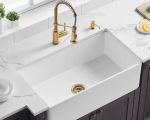How to Install a New Kitchen Sink Faucet: A Step-by-Step Guide
- 1. Preparing for the Installation
- 2. Tools and Materials You’ll Need
- 3. Step-by-Step Installation Process
- 4. Common Mistakes to Avoid
- 5. How to Test Your New Faucet
- 6. When to Seek Professional Help
1. Preparing for the Installation
Before you begin installing your new kitchen sink faucet, it’s important to prepare your workspace. First, clear the area under your sink to give yourself plenty of room to work. Make sure to turn off the water supply to avoid any accidents during the installation process.
It’s also a good idea to protect your kitchen surfaces with towels or a drop cloth, as the installation process can be messy. If you’re replacing an old faucet, take note of how the current faucet is installed, as this will help guide you during the removal process.
2. Tools and Materials You’ll Need
Having the right tools and materials can make your faucet installation much easier. Here’s what you’ll need:
- Adjustable wrench
- Channel-lock pliers
- Plumber’s tape
- Pipe wrench
- Bucket or container for excess water
- New kitchen sink faucet
- Faucet installation kit (usually included with the faucet)
It’s essential to ensure that you have all the necessary materials before you start. If you’re missing any of these tools, visit a local hardware store or check Improvement for all the faucet installation essentials.
3. Step-by-Step Installation Process
Once you’ve gathered all the necessary tools and materials, it’s time to get started. Follow these steps to install your new kitchen sink faucet:
- Remove the Old Faucet: Using your adjustable wrench or pliers, disconnect the water lines attached to the old faucet. Once the water lines are detached, remove the mounting nuts securing the faucet to the sink.
- Clean the Area: Clean the sink area where the faucet sits to ensure a smooth installation. Remove any old plumber’s putty or debris.
- Install the New Faucet: Place the new faucet in position on the sink. Depending on the model, you may need to use the included mounting hardware to secure it in place.
- Attach the Water Supply Lines: Connect the new water lines to the faucet, ensuring that they are tightly secured. Don’t forget to wrap the threads with plumber’s tape to prevent leaks.
- Turn on the Water Supply: Once everything is secured, turn the water supply back on slowly, checking for any leaks around the faucet and water lines.
4. Common Mistakes to Avoid
While installing a new kitchen sink faucet can be a relatively simple task, there are a few common mistakes that you should avoid:
- Not Turning Off the Water Supply: Always make sure that the water supply is turned off before starting the installation to avoid any accidents.
- Using Too Much Plumber’s Tape: While plumber’s tape is essential for ensuring a tight seal, using too much can cause issues with water flow.
- Not Checking for Leaks: After installation, always check for leaks, as even a small drip can lead to water damage over time.
- Skipping the Clean-Up: Neglecting to clean the area around the faucet can cause the new faucet to sit unevenly, leading to potential issues later on.
5. How to Test Your New Faucet
After installing your new kitchen sink faucet, it’s crucial to test it properly. First, turn on both the hot and cold water and check the flow rate to ensure everything is working as expected. Run the water for a few minutes to make sure there are no leaks at the base of the faucet or around the water supply lines.
If you notice any drips or issues, turn off the water supply and double-check all connections. If everything looks good, your new faucet installation should be complete!
6. When to Seek Professional Help
While many DIYers successfully install their own kitchen sink faucet, there are times when it’s best to seek professional help. If you’re dealing with complicated plumbing issues, such as broken or corroded pipes, or if you’re unsure about your ability to complete the installation safely, it may be best to call a plumber.
Additionally, if you notice leaks after installation that you can’t fix, a professional plumber will have the expertise to identify and correct the issue quickly. For the best products and services related to faucet installation, visit Improvement for professional tools and expert recommendations.








